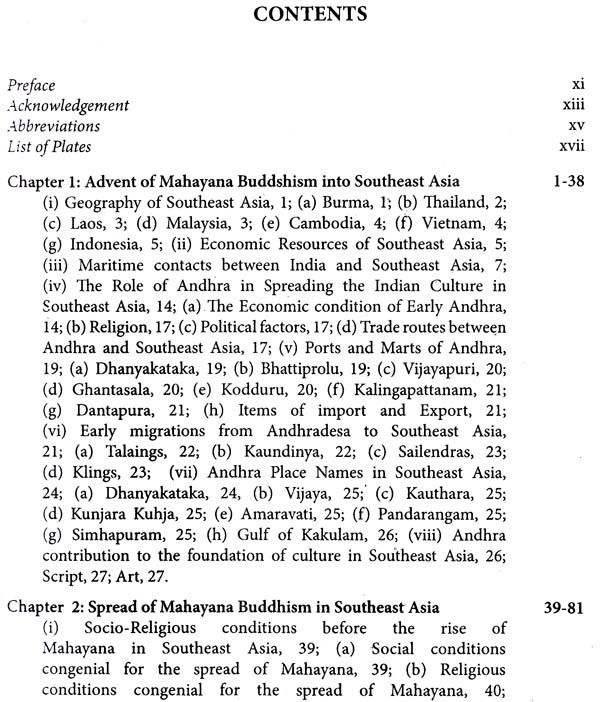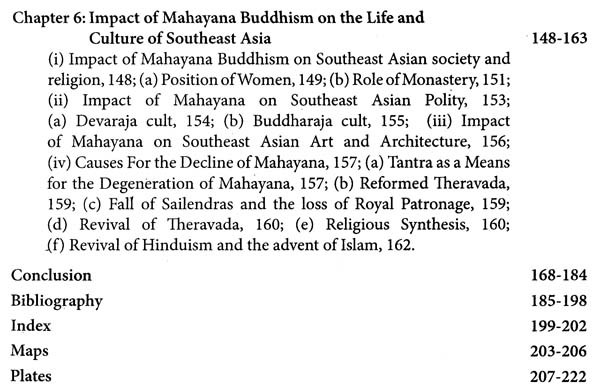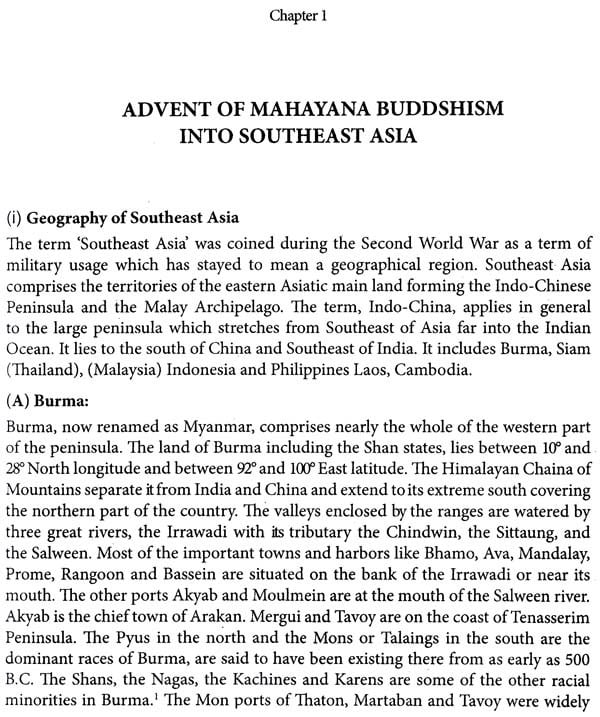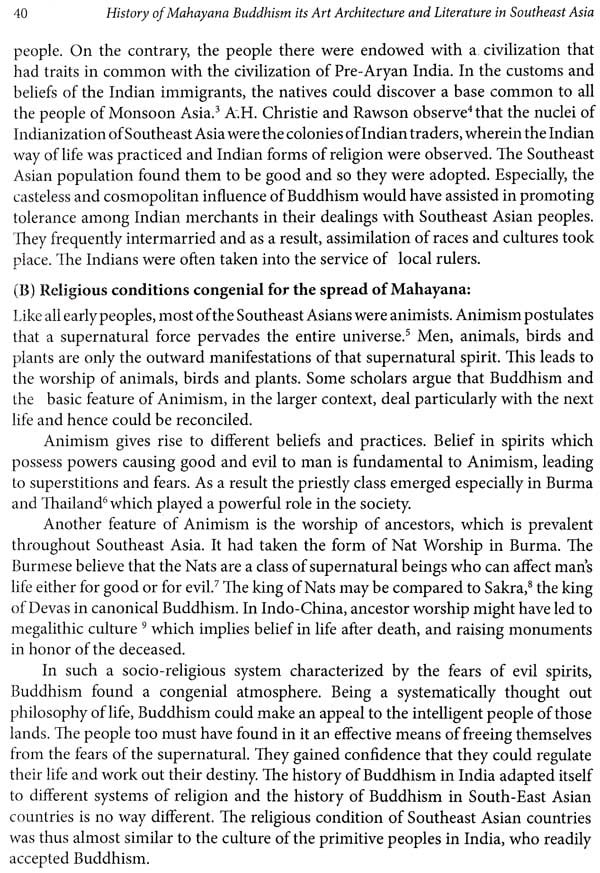
History of Mahayana Buddhism- Its Art Architecture and Literature in Southeast Asia
Book Specification
| Item Code: | AZH094 |
| Author: | Dr. Sitaramamma Jagarlamudi |
| Publisher: | AGAM KALA PRAKASHAN, DELHI |
| Language: | English |
| Edition: | 2017 |
| ISBN: | 9788173201721 |
| Pages: | 238 (Throughout B/W and Color Illustrations) |
| Cover: | Hardcover |
| Other Details | 11.00x9.00 inch |
| Weight | 1.05 kg |
Book Description
Buddhism is vast field spanning a wide variety of concerns. For twenty five centuries Buddhism has inspired the greatest achievements of Asian thought and culture, and today the impact of its message is beginning to be felt in the western world as well. The greatness of the religion lies in the method of its spread. In the entire world religions, Buddhism is the only religion which made its way without persecution, censorship or inquisition. As H.G Wells, the great Historian stated "Buddhism has done more for the advance of world civilization and true culture than any other influence in the chronicles of mankind". Buddhism is not confined to any particular race, nation or country it is universal. Similarly the torch of Dhamma spread to the lands of gold and islands of gold (Suvarnabumi and Suvanadvipa). Andhradesa had been the strong hold of Buddhism from early times and the Andhakas as the Andhra Buddhists were known to Pali literature had been in the forefront of all the later developments in Buddhism. The Mahayana schools of Andhra, and the Andhra Mahayanists who settled at Srilanka have chosen the Southeast Asian countries where there were already commercial colonies set up by Andhra merchants.
Nalinaksha Dutt rightly observes that to South India particularly Andhra goes the credit of being the birth place not only of Mahayana but also its earliest exponents Acharya Nagarjuna and Aryadeva. Buddhism is perhaps the earliest of the missionary religions; it adopted itself to the local condition and absorbed the local systems into itself without any prejudice to its fundamental tenets. That is one of the reason for the rise of different schools and sects not only in India but also Southeast Asian countries. The absorption of the local primitive beliefs and rituals led to the rise of peculiar or even strange principles in each of the countries and in no two countries Buddhist practices look alike. With the rise of worship the Mahayana pantheon like Avalokiteswara, Amitaba, Vajrapani, Manjusri, Prajnaparamita, Tara, Trailokyanatha, Lokanada, Lokeswara huge temples were constructed to these gods all over Southeast Asia. Theravada and Mahayana coexisted in these countries from early centuries but from about the 12th century A.D Theravada became predominant.
Professor Sitaramamma Jagarlamudi born on 5 August 1958 in Andhrapradesh. Completed her Post Graduation from Acharya Nagarjuna University in Ancient Indian History and Archeology in 1980. Later joined in the Centre for Mahayana Buddhist Studies for her PhD and selected for the U.G.C N.E.T fellowship. In 1988 she joined as an Assistant Professor in the Centre for Mahayana Buddhist 'Studies. In 1998 promoted as the Associate Professor and from 2006 onwards serving as the Professor in the Centre for Mahayana Buddhist Studies in different capacities as Head, Chair person Board of Studies. Published more than 60 Research Articles in the National Journals and 25 International publications. Guided 15 PhD Scholars. Participated in various National and International Conferences and presented Research papers. Published one book on The History of Mahayana in Andhradesa.
The present work is an attempt to make a survey of Mahayana elements in Southeast Asian Buddhism. The area of Southeast Asia comprises broadly the Indo-Chinese peninsula and East Indies known to ancient Indian as Suvarnabhumi and Suvarnadvipa The Southeast Asian countries include Burma, Malay Peninsula, Thailand, Cambodia, Laos, and Vietnam, Indonesia and Philippines. The history and culture of these lands have engaged the serious attention and study of several Indian and foreign scholars like R.C.Majumdar. Nihar Ranjan Ray, H.B. Sarkar, K.A.N.Sastri, Sir Charles Eliot. George Coedes, F. D.K.Bosch Reginald Le May and others. But none of these scholars gave a detailed account of different stages in the development of religion in these lands Present archaeological discoveries in the form of inscriptions, sculptures and paintings in Burma, Cambodia, Malay Peninsula and Indonesia clearly indicate that for at least some time Mahayana system of Buddhism was prevalent in these lands and exerted profound influence on the life of these people, and on their literary and artistic achievements. Therefore, there is a need to revise the views of the earlier scholars on the religious developments in these Southeast Asian countries.
Modern historical research on Southeast Asia had begun in the 19th Century A.D. and Most of the scholars paid attention to the history of the later periods. The ancient history of these lands received practically no attention. It may be said that the Dutch are the first to take interest in the history of these lands. In the year 1878 they set up a society in Java for the study of the culture of the Indonesian people. The society inspired numerous studies in the early history and culture of Indonesia. Among the Dutch there were both historians and archaeologists including epigraphists, like Hendrick Kern, Brandes, Cohenstuart and Holie. The last mentioned in Indian Universities on Southeast Asian Buddhism, Such as Sukumar Sen Gupta his work on Buddhism in Southeast Asia (Calcutta, 1975) which is mainly based on Southeast Asian inscriptions and Be, Sam's work The impact of Buddhism on Cambodian Social life (Puna, 1974-78).
**Contents and Sample Pages**













